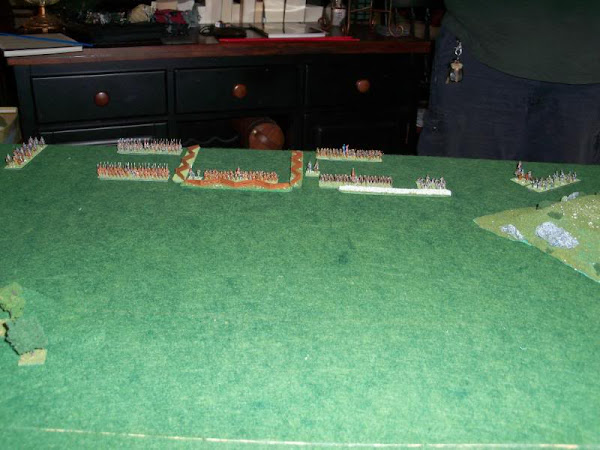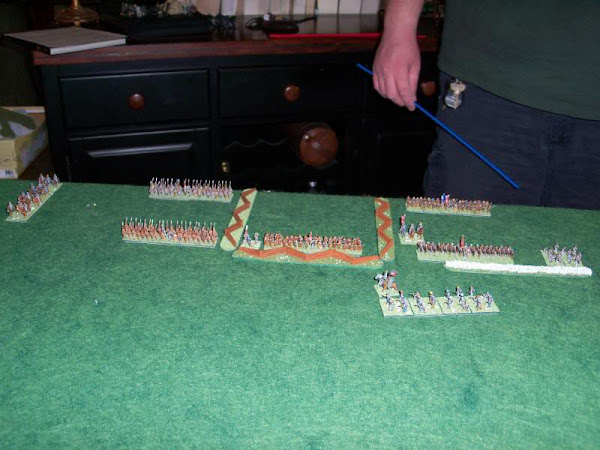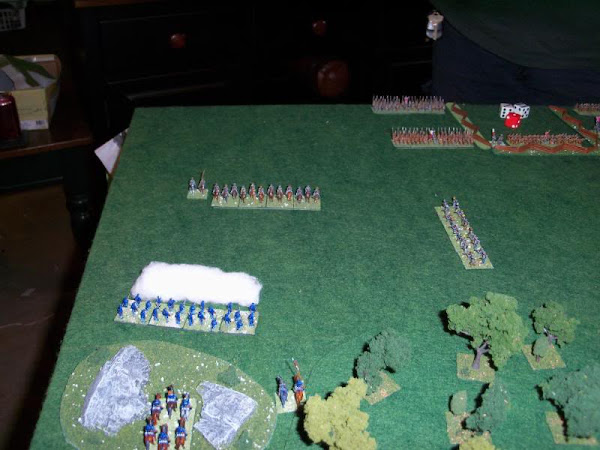I recently had a chance to play my first game of Warlord Games BLACK POWDER: Battles with Model Soldiers in the Age of the Musket . If you're interested in learning more about the rules, you can read my Review of Black Powder, which is pretty extensive. I'll also include comments on the rules in the following battle report. I will put rules comments in italics to separate them from descriptions of the battle.
. If you're interested in learning more about the rules, you can read my Review of Black Powder, which is pretty extensive. I'll also include comments on the rules in the following battle report. I will put rules comments in italics to separate them from descriptions of the battle.
The Setup
We would be using Black Powder to play an American Civil War game with my fledgling collection of 10mm ACW miniatures. As suggested in the rulebook when using 10mm miniatures, we made all measurements in centimeters instead of inches. I commanded the Union forces, consisting of one brigade of 5 standard Infantry regiments with no special rules, and a brigade of to Cavalry regiments plus one rifled horse artillery battery. The Cavalry were the standard mounted infantry type listed in the Black Powder book, and armed with breech-loading carbines. My opponent commanded the Confederate forces, which also consisted of one brigade of standard Infantry regiments with no special rules, and a brigade of two Cavalry regiments but with a smoothbore horse artillery battery. I made the Confederate Cavalry regiments a little different, to represent them being used more as raiders than mounted infantry, so I armed them with pistols and shotguns, which would give them severely limited range when shooting. I also increased their combat value when mounted by one, up to 6, and gave them the Marauders special rule, so they would ignore any distance penalties on their command checks. The result was that they could operate completely independently, and that they would be better fighting on horseback and charging in than dismounting and firing. The Union cavalry was the opposite, as they had to stick together, and were better off dismounting and engaging at range. I figured this would suit both pretty well, and allow for some variety in the two armies while still making them pretty even.
We didn't have a scenario to play, and we wanted to keep things pretty simple because this was the first game of Black Powder for both of us, and we didn't need a lot of extra stuff to remember while we tried to learn the rules. So we decided on a simple rearguard scenario. My Union forces were the forward elements of my army, pursuing a retreating enemy army. My opponents force was the rearguard, there to hold off my advance long enough for the main army to make their escape. I set up the terrain so my opponents side of the board had a fenced in area, and a rocky wall, so he would have some linear obstacles. I figured either they would probably have prepared a bit of a defensive position in case the army had to retreat. I would deploy my entire force first withing 16cm of my board edge. My opponent would then deploy his entire force within 16cm of his board edge. I would have the first turn. We were pretty vague on victory conditions, since we weren't sure what would work well. I just had to drive the Confederates from the battlefield in a reasonable amount of time, whatever we determined that to be. My opponent had to delay that happening for as long as possible, to give the main Confederate army time to retreat.
This scenario ended up working out well in relation to some previous battles we had fought using Piquet's Field of Battle. These battles involved small Union and Confederate forces fighting bitterly over control of a mill. You can read about the first day of the Battle of Prescott's Mill (including my thoughts on the Field of Battle rules) here (battle report) and here (story). The battle report for Day 2 of the Battle of Prescott's Mill can be read here (Part 1) and here (Part 2). Clearly the battle between these two small forces was just part of a larger battle taking place nearby. Now the Union had won that battle, and the Confederate army was preparing to withdraw. Because of the direction the army planned to retreat in, an area near Prescott's Mill was the best place to set up defenders to delay the Union pursuit. Having capture the Mill on the previous day, the small Union force was closest and in the best position to quickly break through the rearguard to get to the main Confederate army.
We rolled randomly for officer traits for our Brigade commanders. The commander of my Infantry brigade, the Irish Brigade, rolled standard for everything. The commander of my Cavalry Brigade, Brigadier General George Armstrong Custer, appropriate rolled high for aggression, giving him +1 on his command rolls when giving an order to charge. The Confederate Infantry commander, Brigadier General John Bell Hood, rolled high for Aggression and Independence. This meant he also got +1 on his command rolls when ordering a charge, and he could always choose to re-roll any failed command roll, but if the re-roll also failed it would count as a blunder. Normally a blunder occurs when a double 6 is rolled on the command roll, and it requires rolling on a chart to determine what kind of blunder occurs. The Confederate Cavalry commander, Nathan Bedford Forrest, oddly rolled low for Aggression, meaning he was -1 on any command roll when ordering a charge. He must have been feeling timid following the defeat of the previous day, when his Cavalry was run off by Custer's.
The photographs below show the initial deployments of our forces. The Union Infantry was formed up in two lines, three regiments in front, and two behind in support. Their Cavalry and Horse Artillery were in column on the far left flank, hoping to advance toward the enemy flank before they were notice. The Confederate Infantry was deployed in a similar formation, three regiments in front and two behind in reserve, but they had some linear obstacles to deploy behind, and had the horse artillery deployed at the left of their line. The two Cavalry regiments were deployed in column on either side of the Infantry, ready to respond to any threat and protect their flanks.
Union Turn 1
The Union Cavalry Brigade advanced quickly up the left flank, but paused as they reached a rocky area of ground on the far side of the forest. Examining the area, Custer determined that he could make his way through a ravine between the large rock formations, but it would be rough going. We had decided at the beginning of the game that the large rocks on those terrain pieces were impassible, and the rest of the area counted as rough ground, which would halve movement rates. Brigadier General Meagher took a long time getting his Infantry brigade organized, and they had yet to advance. The entire brigade was ordered to advance at full speed, but the command roll was failed so they did not move. In retrospect, I should have deployed them in march column to begin with, as this gives a bonus to the command roll and allows a single move even if the roll is failed. Then I could have advanced faster, and deployed into line once I was closer to the enemy.
Confederate Turn 1
The attempted flanking maneuver by the Union cavalry was spotted and reported to General Forrest. In response, he began moving the 4th Tennessee Cavalry over to the right flank of the Confederate line to intercept them. The other Cavalry regiment awaited orders. The Infantry stayed in their carefully prepared positions.
Union Turn 2
Having briefly surveyed the terrain, Custer ordered his Cavalry brigade to advance between the large rocks, with the artillery in the rear and the 5th Michigan in front. They made slow progress over the rough ground, and were already behind schedule having not made it nearly as far as they had wished. Luckily the Infantry brigade was also behind schedule. Major General Hancock intervened, getting the troops into order and moving forward, albeit slowly. This turn I gave the order to advance with the Commander in Chief, rather than the commander of the brigade. There was no actual benefit to this in the game, but I figured it couldn't hurt. In Black Powder, you can issue orders to multiple units at a time, as long as they are all getting the same order, and they all start and end their move within 6 cm of one another. For most of the game I was ordering this whole Infantry brigade to advance straight forward at full speed. I tried wording the order differently sometimes, but I still never rolled more than one move, and sometimes zero.
Confederate Turn 2
The Confederate Cavalry regiment on their right flank advanced a little and formed into line, preparing to launch an attack on the Union Cavalry once it emerged from the ravine. The rebel Cavalry regiment from their left flank continued to cautiously advance over to the right flank to support their fellow Cavalry.
Union Turn 3
The Union cavalry saw the approaching threat to their front, but their advance was still slowed by the rocky ground in the ravine. The front Cavalry regiment, the 5th Michigan, managed to make it out of the ravine, form into line, and dismount. They opened fire at long range with their carbines, but it had little effect. The Infantry brigade continued their slow, methodical advance forward, with the usual results.
Confederate Turn 3
The Confederate Cavalry regiment that had come from the left flank advanced a little farther and formed into line, ready to charge if they sensed an opportunity. Forrest considered ordering the other Cavalry regiment to charge the dismounted Union Cavalry before the rest of the brigade had a chance to make it out of the ravine, but he decided against it, considering it too risky. He would wait until both his regiments were in position. My opponent issued the order for the regiment to charge the dismounted Union Cavalry, but the command test was failed, probably due to Forrest's timid disposition that day.
Union Turn 4
The rear Cavalry regiment and horse artillery were ordered to move out of the ravine and form a line on either side of the dismounted 5th Michigan, but they were slowed by the rocky terrain in the ravine and the confusion which it caused as horses bunched up in bottlenecks. The dismounted regiment wheeled slightly to make sure their flank was not exposed to the enemy Cavalry regiment to their right. They fired at the closer enemy regiment, but due to the high morale of the Tennessee cavalry, they were unaffected by the fire. The Union Infantry brigade once again advanced forward at an extremely cautious pace.
Confederate Turn 4
With both of his Cavalry regiments now in position to support each other, Forrest ordered the rightmost regiment to charge the dismounted Union Cavalry. The other regiment was ordered in behind to support the assault. In the background you can see the rightmost Confederate Infantry regiment has wheeled a little to keep it's flank protected, in case the Union cavalry got past their Confederate counterparts. The Confederate Cavalry in the back fired a few long range pot shots with their pistols at the Union Cavalry regiment still in column, which had no effect, and then moved to support the assault. The dismounted Union Cavalry regiment fired at the charging Confederates as the horses thundered down on them, their accurate and devastating fire disordering the enemy and blunting their charge. The charge still struck home, however, and became a swirling melee as the mounted Confederates rode through the loose Union line firing pistols and shotguns at closer range, and the Union Cavalry defended themselves with their breech-loading carbines. There were many casualties on both sides, and the Union regiment nearly broke and fled, but just barely held together. A unit that is charged in the front can fire closing fire on their attackers and, like normal firing, rolling a 6 to hit means that the enemy becomes disordered. It goes away after a turn, but until then the unit can't voluntarily move, and it has a negative modifier on their shooting and close combat hit rolls. Normally the Confederate Cavalry would have been 3+ to hit because of a bonus for charging, but the disorder brought them back to 4+ to hit, same as the dismounted Union Cavalry. The Union regiment could only roll 4 dice, compared with the 6 that the mounted Confederates could roll. The Union regiment lost the combat by taking one more casualty than the Confederates. This meant they had to take a break test with no modifiers. They barely passed, rolling the minimum number they could get without breaking. It's worth pointing out that we assumed you don't become disordered when an enemy rolls a 6 to hit you in combat, only from 6 to hit when shooting. That may be wrong, but I couldn't find anywhere that specified, and I haven't gone back to check.
Well, things were just starting to heat up, but this post is getting a bit long. I think I will save the rest for another post. Be sure to come back soon to read the conclusion of the battle report, and find out if my ponderous Union Infantry ever managed to make it into contact with the enemy.












Great story well done may. Were you figure based for Blackpowder or another system?
ReplyDeleteCheers
Mark